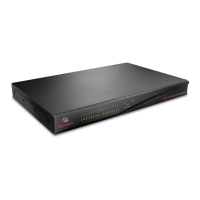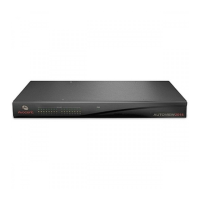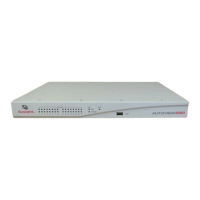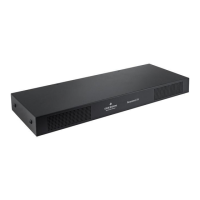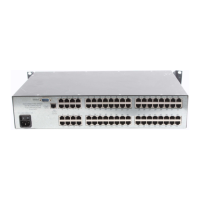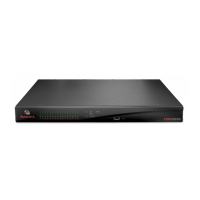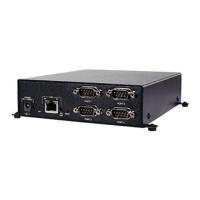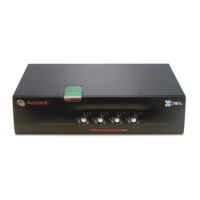Do you have a question about the Avocent AUTOVIEW 3008 and is the answer not in the manual?
Overview of AutoView 3008/3016 switch features and benefits for flexible control of servers.
Describes how the switch transmits KVM information and its network connectivity.
Outlines the general procedure for setting up and installing the switch.
Provides instructions and safety considerations for mounting the switch in a rack.
Details the steps for connecting the switch hardware and powering it on.
Explains how to configure network settings via OSCAR or OBWI interfaces.
Discusses opening firewall ports for OBWI access and typical configuration scenarios.
Explains how to verify Ethernet and IQ module connections using LEDs.
Describes how to cascade multiple AutoView switches using CAT 5 cables.
Steps to select a target device to reconfigure local keyboard and mouse settings.
Interpreting status symbols for target devices in the OSCAR interface.
Guide to using keyboard and mouse for OSCAR interface navigation.
Accessing firmware version details and performing firmware upgrades.
Overview of the On-Board Web Interface for KVM switching.
Logging into the OBWI and navigating the Explorer window.
Initiating a KVM session via the Explorer browser window.
Managing active user connections through the OBWI Status tab.
Creating, modifying, and deleting user accounts and managing security.
Defining user roles and their allowed operations.
Viewing and changing appliance configuration parameters.
Procedures for upgrading switch and IQ module firmware.
Setting up LDAP for user authentication and directory services.
Description of the Video Viewer window and its Java-based operation.
Overview of the Video Viewer window's interactive elements and capabilities.
Options for aligning cursors, refreshing screens, and scaling images.
Steps to configure network settings using the Console menu.
Procedure to upgrade switch firmware via the Console menu.
Steps to recover the switch after a failed firmware upgrade.
Steps to configure serial port communication parameters and appearance.
Steps to follow to get technical assistance for product issues.
Overview of AutoView 3008/3016 switch features and benefits for flexible control of servers.
Describes how the switch transmits KVM information and its network connectivity.
Outlines the general procedure for setting up and installing the switch.
Provides instructions and safety considerations for mounting the switch in a rack.
Details the steps for connecting the switch hardware and powering it on.
Explains how to configure network settings via OSCAR or OBWI interfaces.
Discusses opening firewall ports for OBWI access and typical configuration scenarios.
Explains how to verify Ethernet and IQ module connections using LEDs.
Describes how to cascade multiple AutoView switches using CAT 5 cables.
Steps to select a target device to reconfigure local keyboard and mouse settings.
Interpreting status symbols for target devices in the OSCAR interface.
Guide to using keyboard and mouse for OSCAR interface navigation.
Accessing firmware version details and performing firmware upgrades.
Overview of the On-Board Web Interface for KVM switching.
Logging into the OBWI and navigating the Explorer window.
Initiating a KVM session via the Explorer browser window.
Managing active user connections through the OBWI Status tab.
Creating, modifying, and deleting user accounts and managing security.
Defining user roles and their allowed operations.
Viewing and changing appliance configuration parameters.
Procedures for upgrading switch and IQ module firmware.
Setting up LDAP for user authentication and directory services.
Description of the Video Viewer window and its Java-based operation.
Overview of the Video Viewer window's interactive elements and capabilities.
Options for aligning cursors, refreshing screens, and scaling images.
Steps to configure network settings using the Console menu.
Procedure to upgrade switch firmware via the Console menu.
Steps to recover the switch after a failed firmware upgrade.
Steps to configure serial port communication parameters and appearance.
Steps to follow to get technical assistance for product issues.
| Number of Ports | 8 |
|---|---|
| Video Resolution | Up to 1920 x 1200 |
| Maximum Resolution | 1920 x 1200 |
| USB Ports | Yes |
| Audio Support | No |
| Form Factor | 1U Rackmount |
| Weight | 2.5 kg |
| Product Type | KVM Switch |
| KVM Ports | 8 |
| Local Users Supported | 1 |
| On-Screen Display (OSD) | Yes |
| Video Bandwidth | Up to 200 MHz |
| Operating Temperature | 0 to 50 °C |
| Connector Type | USB |
| Storage Temperature | -20 to 60°C |
| Humidity | 0 to 80% non-condensing |

